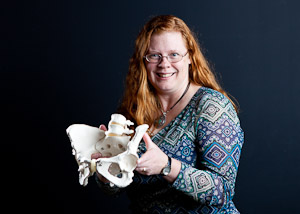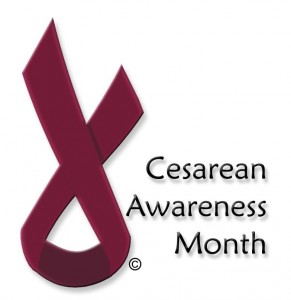The Childbirth Educator's Role in The Cesarean Epidemic: 10 Steps You Can Take Now!
By: Sharon Muza, BS, LCCE, FACCE, CD/BDT(DONA), CLE | 0 Comments

Andrea Lythgoe
http://andrealythgoe.com
As Cesarean Awareness Month (April 2014) comes to a close, I wanted to share ten things that childbirth educators can do in their childbirth classes to support families to avoid unneeded cesareans, help families to have a cesarean birth that is respectful and family centered and support families who give birth by cesarean, (planned or unplanned) both during the birth, in the postpartum period and when planning future births.
1. Birth plan exercises
Have your birth planning/birth choices activity include preferences for a cesarean birth. Allow parents the option to select items such as delayed cord clamping, skin to skin in the operating room, delaying newborn weights and measurements, and more. While these may not be available options in all areas, encouraging discussion amongst families and their health care providers is a good place to start. Additionally, consider role playing a cesarean section in class and discuss ways to make the procedure family friendly. Remember to suggest ways that the partner and other support people can best support mother and baby during the surgery. Consider sharing "The natural caesarean: a woman-centred technique" video so families can explore options for a family friendly cesarean birth.
2. Access teaching resources on the Lamaze International website
Lamaze International offers some great teaching resources on cesareans for educators on their website and for families on the Lamaze International parent site. There are two infographics that cover the topic of cesarean sections; "Avoiding the First Cesarean" and "What's the Deal with Cesareans." You might consider showing the brand new infographic video to your families in class. At only 3 minutes long, it does a great interactive job of highlighting important information. In addition to using these materials in class, encourage families to explore them more thoroughly at home.
3. Provide current statistics
Access and share statistics about national and provincial or state cesarean rates and VBAC rates, along with local rates for facilities and providers if available. Help your families to understand the difference between overall cesarean rates and primary cesarean rates and why facilities caring for high risk mothers or babies might have higher rates. Make sure that you are providing the most current information available, and update your figures when new numbers are released. Encourage discussion in class with families who are considering changing birth location or providers if they feel so inclined.
4. Encourage the use of birth doulas
The addition of trained labor support has been shown to reduce common interventions and cesareans. (Hodnett, 2012) Take some time during class to share how doulas can help support both the laboring woman and her partner and team. Provide resources for families to locate doulas (DONA.org and DoulaMatch.net are two such lists that come to mind) and briefly share information on questions to ask a doula during an interview, so the families are prepared.
5. Share current best practice information
Be sure that the information in your classes is current, accurate and based on best practices and evidence. Know the sources of the information you cover. Make sure it is up to date and verifiable. Have a short list of favorite online resources to share with families, including Lamaze International's Giving Birth with Confidence blog- written specifically for parents. Utilize the references that make up the Six Healthy Birth Practices, there is a citation sheet for all six of the birth practices.
6. Support the midwifery model of care
Share information in your classes about the midwifery model of care, which has been shown to be an appropriate choice for healthy, low risk women. Let your class families know how to find a midwife by using the search functions on the American College of Nurse-Midwives website and information on finding a midwife on the Citizens for Midwifery website.
7. Have meaningful class reunions
If your childbirth class includes a reunion, create a space for all the families to share their stories, both the vaginal births and the cesarean births. Honor the work that the families did to birth their babies and celebrate their intention and teamwork. Highlight their shining moments and let them know that you recognize how hard they worked. Model excellent listening skills and support all the families as they share their birth stories.
8. Provide support group information
Make sure that all families that leave your class have been given resources for a support group for women who birth by cesarean section. Access the International Cesarean Awareness Network (ICAN) to find the nearest local ICAN chapter website or Facebook group. Or refer the families to the main ICAN Facebook page. VBACFacts.com also has a large peer to peer support network active on Facebook as well.
9. Share postpartum resources
Families that birth by cesarean section might find themselves needing additional support from professionals during the postpartum period. Be sure that they have resources to find lactation consultants, mental health counselors, postpartum doulas, physical therapists and other professionals that might be useful for healing emotionally and physically from a cesarean section. In the throes of postpartum hormones, exhaustion, sleep deprivation and physical recovery, having to hunt down appropriate professionals can be a daunting task for any new families, never mind a mother recovering from surgery with a newborn.
10. Offer a cesarean only class
Some families know they will be needing a cesarean for maternal or infant health circumstances and are hesitant about taking the standard childbirth class, feeling like they won't fit in. While they may not be needing the coping skills or comfort techniques and pushing positions that you cover in the typical childbirth class, they do need information about the cesarean procedure, pain medication options, recovery, breastfeeding and newborn care/procedures and informed consent and refusal information, among other things. Having a class designed with their needs in mind can help them to make choices that feel good to them and participate in the community building that is such an important part of childbirth classes.
Don't underestimate the role of the childbirth educator (you!) to offer evidence based information, appropriate resources, respectful dialogue along with skills and techniques to help women to have the best birth possible, avoid a cesarean that is not needed and recover and heal while feeling supported with options for future births. Thank you for all you do to help women to avoid cesareans or if needed, have the best cesarean possible.
References
Hodnett, E. D., S. Gates, et al. (2012). "Continuous support for women during childbirth." Cochrane database of systematic reviews: CD003766.
Published: April 28, 2014
Tags
Childbirth educationCesareanCesarean Awareness MonthVBACHealthy Birth PracticesICANLabor/BirthMaternal Infant CareInternational Cesarean Awareness Network